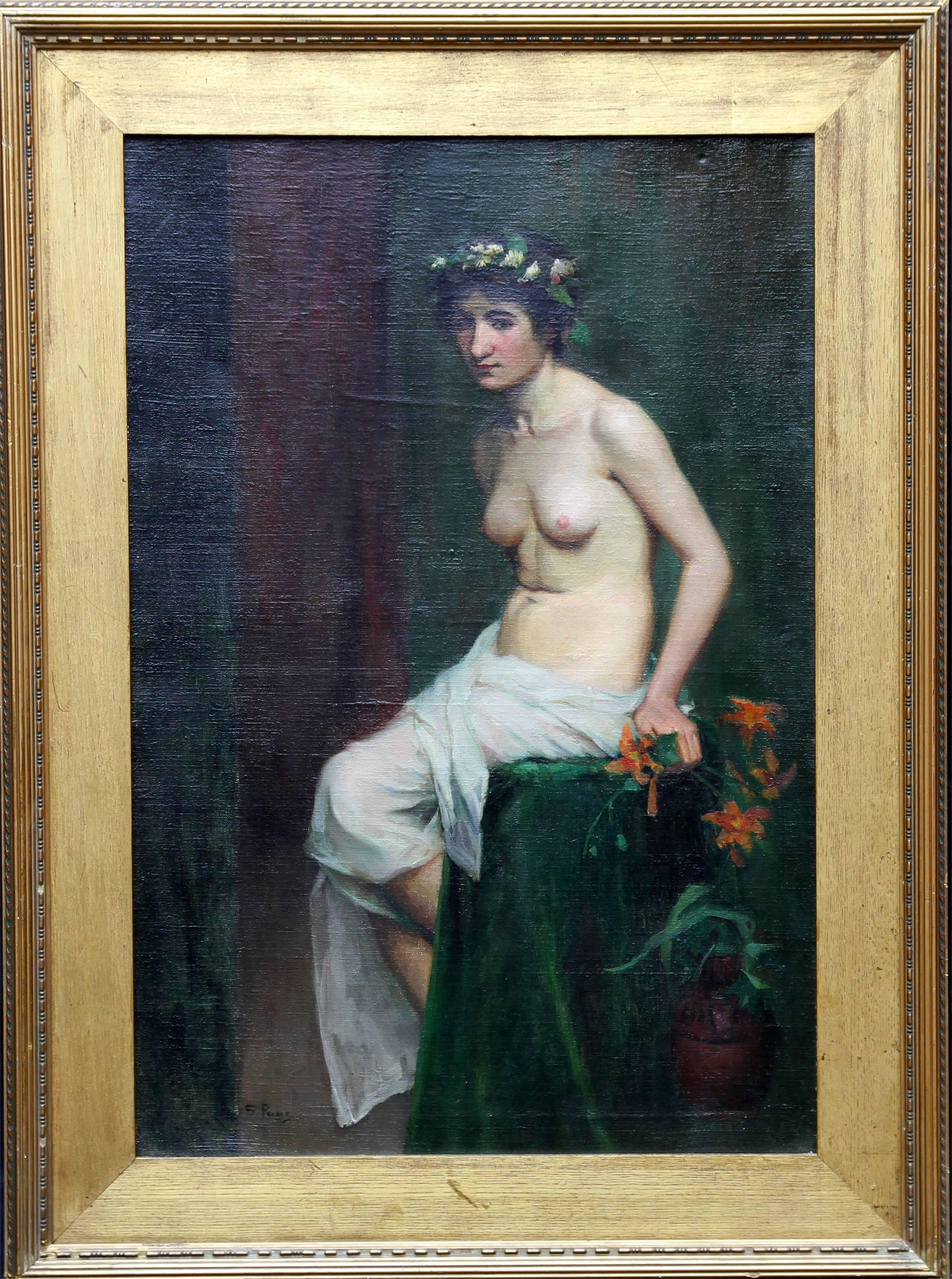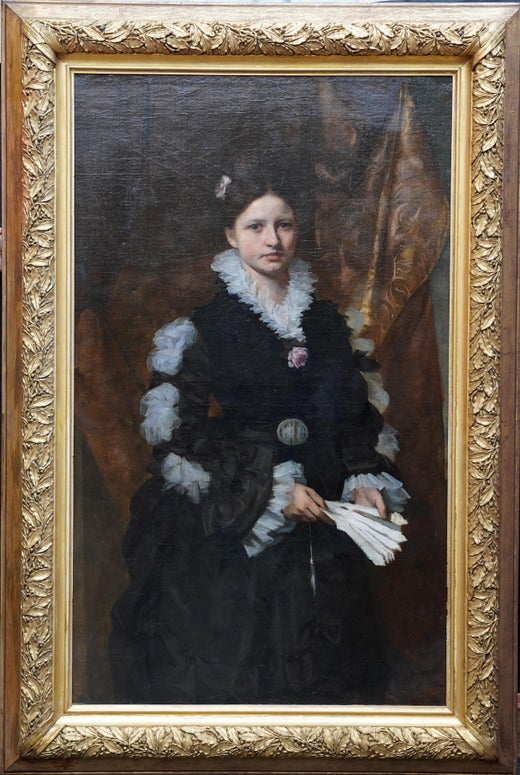Items Similar to Portrait of an Elegant Lady - Austrian Symbolism 19th century art oil painting
Want more images or videos?
Request additional images or videos from the seller
Eduard VeithPortrait of an Elegant Lady - Austrian Symbolism 19th century art oil paintingCirca 1890
Circa 1890
About the Item
This stunning large portrait oil painting is by noted Austrian portrait painter Eduard Veith. Painted circa 1890 it is a standing three quarter length portrait of an elegant lady from Viennese society. The influences of Symbolism and Gustave Klimt (1862-918) and the Vienna Secession movement can be seen in the rich golden decorative drape behind the sitter. The detail of the lace in her sleeves, wrists and neck are superb as is the detail in her facial features. An excellent example of early Austrian symbolism and of Veith's work and housed in a fine acanthus gold leaf exhibition frame.
Signed lower right.
Provenance. Austrian estate.
Condition. Oil on canvas, image size is 50 inches by 32 inches and in good condition.
Frame. Housed in a gold leaf exhibition gilt frame, 58 inches by 39 inches framed and in good condition.
Eduard Veith (30 March 1858, Neutitschein – 18 March 1925, Vienna) was an Austrian portrait painter and stage designer. Many of his works were influenced by Symbolism. He was born to the decorative painter, Julius Veith (1820–1887), and his wife Susanna, née Schleif (1827–1883). At first, he received training to follow in his father's profession. Later, he went to Vienna, where he took classes at the Museum of Applied Arts from Professor Ferdinand Laufberger. He capped off his studies by creating sgraffito for exhibition buildings at the Exposition Universelle in Paris. He then returned home, where he assisted his father with painting churches, synagogues and other ceremonial buildings. This was followed by several study trips; to Italy, Belgium and Tunisia. He finally settled in Vienna; becoming a free-lance artist and working mostly by commission. From 1890, he was a member of the Vienna Künstlerhaus. In 1896, he received a gold medal at the Große Berliner Kunstausstellung. In 1905, he was appointed a Professor at the University of Technology.[1] In 1911, he married Bertha Griesbeck (1872-1952), from Augsburg. He later taught at the University of Applied Arts Museum of Applied Arts, and became a Professor there in 1920. During his years in Vienna, he maintained contact with his home town, and held exhibitions there. In addition to his paintings, he did interior decorations for a number of the buildings on the Ringstraße, and trompe l'oeil stage sets. He often collaborated with the architects, Fellner & Helmer, who built dozens of theatres and opera houses throughout the Austro-Hungarian Empire. He died shortly before his sixty-seventh birthday, and was interred at Döbling Cemetery. His grave is adorned with a sculpture by Georg Leisek.
- Creator:Eduard Veith (1858 - 1925, Austrian, Czech)
- Creation Year:Circa 1890
- Dimensions:Height: 58 in (147.32 cm)Width: 39 in (99.06 cm)Depth: 2 in (5.08 cm)
- Medium:
- Movement & Style:
- Period:
- Condition:
- Gallery Location:London, GB
- Reference Number:1stDibs: LU853113069662
Eduard Veith
Eduard Veith was an Austrian portrait painter and stage designer. Many of his works were influenced by symbolism.
About the Seller
5.0
Platinum Seller
These expertly vetted sellers are 1stDibs' most experienced sellers and are rated highest by our customers.
1stDibs seller since 2018
400 sales on 1stDibs
Typical response time: <1 hour
- ShippingRetrieving quote...Ships From: London, United Kingdom
- Return PolicyA return for this item may be initiated within 14 days of delivery.
More From This SellerView All
- Portrait of Girl in Straw Hat - British Victorian art Newlyn School oil paintingBy Frank BramleyLocated in London, GBNewlyn School, circle of Frank Bramley is the attribution for this lovely Victorian portrait oil painting. Painted circa 1890 on panel, it is a head and shoulders portrait of a young girl in a straw hat...Category
19th Century Victorian Portrait Paintings
MaterialsOil
- Portrait of Charlotte Julianna Jane Howard - British Victorian art oil paintingLocated in London, GBThis lovely British Victorian portrait is by noted artist Richard Buckner. Painted circa 1840 it is a half length seated portrait and the sitter is Charlotte Julianna Jane Howard, 3r...Category
1840s Victorian Portrait Paintings
MaterialsOil
- Portrait of a Flower Seller - British 19th century Victorian art oil paintingLocated in London, GBThis charming British Victorian portrait oil painting is by artist Harry Leslie Baldry. It was painted in 1887 when Baldry was based in London. The composition is a three quarter len...Category
19th Century Victorian Portrait Paintings
MaterialsOil
- Pre-Raphaelite Beauty - Victorian art nude oil portrait - British female artistBy Sara Wells PageLocated in London, GBPainted by Sara Wells Page this is a large stunning half-length Pre-Raphaelite portrait oil painting of a semi clad young woman. It was painted circa 1900 by Page who worked and exhi...Category
Early 1900s Victorian Nude Paintings
MaterialsOil
- Portrait of Emma Woods - British Victorian art oil painting noted female artistBy Annie Louisa SwynnertonLocated in London, GBThis stunning British Victorian portrait oil painting is by noted female artist Annie Louisa Swynnerton. The sitter is Emma Woods, nee King (1806-1896). Emma was the wife of Samuel ...Category
1890s Victorian Portrait Paintings
MaterialsOil
- Portrait of Girl with Puppy - British Victorian portrait oil painting dog artLocated in London, GBThis Beautiful Victorian oil painting is attributed to Scottish master Sir George Reid. Painted circa 1870, the detail in the young girl's facial features and hair are just stunning,...Category
19th Century Victorian Animal Paintings
MaterialsOil
You May Also Like
- Victorian 19th century arts and crafts figure scene from a Shakespeare playBy Robert Anning BellLocated in Woodbury, CTVictorian 19th-century arts and crafts figure scene from a Shakespeare play Robert Anning Bell was born on 14 April 1863 and educated at University College School in London. At the age of fifteen, he was articled for two years to an architect uncle before studying at the Royal Academy Schools, the Westminster School of Art (under Fred Brown), in Paris (under Aimé Morot...Category
Early 1900s Victorian Figurative Paintings
MaterialsOil
- Portrait of a British Naval LieutenantLocated in Boston, MA'Portrait of British Naval Officer' is attributed to the British painter and engraver Daniel Orme (1766-c.1832) based on the scratched inscription verso, as well as its similarity to Orme’s known engraving oeuvre. The oil on tin portrait bears the scratched inscription “D. Orme” verso, which in the absence of contravening evidence as to the artist is significant in attributing the work to Orme. Katherine Coombs, Curator of Paintings at the Word & Image Department of the Victoria and Albert Museum, London and the writer of the Dictionary of National Biography article on Orme, states that Orme is “so obscure an artist that if his name is indeed scratched on the [tin] that seems good evidence for it being so.” Additionally, Orme’s stipple engravings of prominent naval figures in oval, including John Hunter in 1792, Horatio Nelson in 1798, among others at the National Portrait Gallery, London are consistent with the style and composition of the portrait. Roger Quarm, Curator of Paintings at the National Maritime Museum, Greenwich notes that Orme’s “engraved portraits of naval officers tend to be oval”. Orme is known to have issued a series of engravings by subscription that included portraits of popular naval Admirals and Officers in 1797. Two oils in the collection of the National Maritime Museum, also demonstrate Orme’s execution of naval subject matter. The sitter has been identified as a lieutenant in the British Navy wearing the “full-dress uniform for the period 1787-1812,” according to Roger Quarm. Alfred Umhey has confirmed this identification of the sitter as a “lieutenant in the uniform pattern 1787-1795, which is however worn post that date.” The medal worn around the sitter’s neck has been identified as the Sultan’s Medal for Egypt issued in 1801, by both Quarm and Umhey. The Sultan’s Medal for Egypt or the Turkish Medal for Egypt was issued in 1801 to members of the British Army and Navy by Sultan Selim...Category
Early 19th Century Victorian Portrait Paintings
MaterialsOil
- Painting, 19th century, women portrait, oil on canvas.Located in Berlin, DEPainting, 19th century, women portrait, oil on canvas. Dimensions with frame 63cm x 77.5cmCategory
19th Century Victorian Portrait Paintings
MaterialsCanvas, Oil
- Pair of Antique Paintings, Oil on Canvas, Portraits. Around 1850.Located in Berlin, DEPair of antique paintings, oil on canvas, portraits. Around 1850. Portrait of a well-known artist and his wife. Dimensions are per painting...Category
19th Century Victorian Portrait Paintings
MaterialsCanvas, Oil
- English portrait of an Elegant Lady with important frame "Mrs W. Butt"Located in Brooklyn, NYBorn on 13 March 1824 in Lymington, Hampshire, George Elgar Hicks was the second son of a wealthy magistrate. His parents encouraged Hicks to become a doctor and so Hicks studied med...Category
1870s Victorian Portrait Paintings
MaterialsCanvas, Oil
- The Artist's StudioBy Irving E. HurlburtLocated in Storrs, CTThe Artist's Studio. c. 1914. Oil on canvas. 24 1/8 x 32. The canvas is in fine condition, having been professionally lined, cleaned and varnished. The painting is housed in a 29 1/2 x 37-inch Sully-style gold frame. Signed, lower right and also on the verso of the canvas in the center of the image. Hurlburt apparently created a 'period piece' work of art. The two maids are dressed in late 19th-century clothing. The slight puff at the top of the sleeve is 1897 - 1898. The maid on the left has her scarf done in a way that is quite Dutch or Flemish. The woman on the right has a headscarf that could just be the tie of the scarf making that shape in the front. If her hair is done up with a chignon in the back causing the scarf to be full in the back, the placement of that bun would make the piece 1908 - 1912. The "Psyche knot" was very popular in 1910. The woman in the painting on the easel is maybe old fashioned with a simpler and fuller version of early 20th century hairstyles. It's hard to tell if what is around her neck is a boa or a collar, but boas of all shapes and sizes were popular in the 1890's. Her gown is decidedly unfitted and appears to have a loose belt at the waist. If the skirt is in layers with the light skirt length over a darker skirt, that would put the outfit in 1910 or 1914. The problem is the waist. In 1910 - 1912 it was a neo-empire revival with a high waist. It wasn't until 1914 that the waists were coming back down with sashes at the waistline. It is just not specific enough to see the details that would help to date it. I guess I would be inclined to date it more 1914 - the approximate date of the woman in the painting, and assuming that the maids are dressed in an old fashioned way, but their skirts are awfully full and long for the period to be practical for cleaning. Irving E. Hurlburt lived and worked in New Haven, Connecticut. For most of his life, he resided at Wolcott Street in New Haven. Possibly the room is the artist's studio. He studied at the Yale School of Fine Arts, 1890-93 He was a member of the New Haven Paint and Clay Club. In 1888 he received the Ethel Childe Walker Prize at the Yale School of Fine Arts. His sketches of Pictures of New Haven show historic buildings, scenes and events of New Haven, CT. They were reproduced as wood engravings in the New Haven Almanack for the years 1906 to 1913, published by Ye Olde Hardware Store of the John E. Bassett Co. His other published sketches in that venue were: The Tontine Coffee House, Mayor Roger Sherman...Category
Early 20th Century Victorian Portrait Paintings
MaterialsOil






